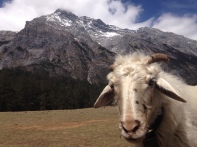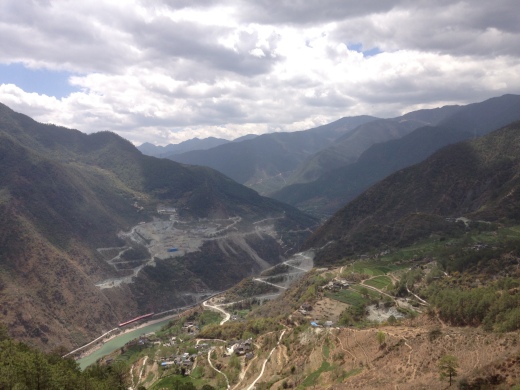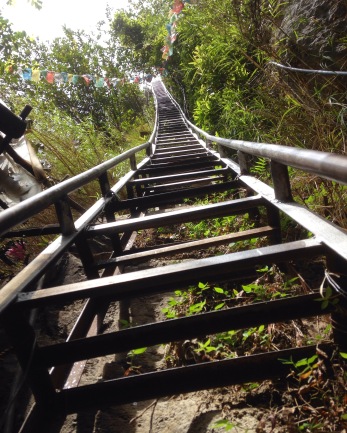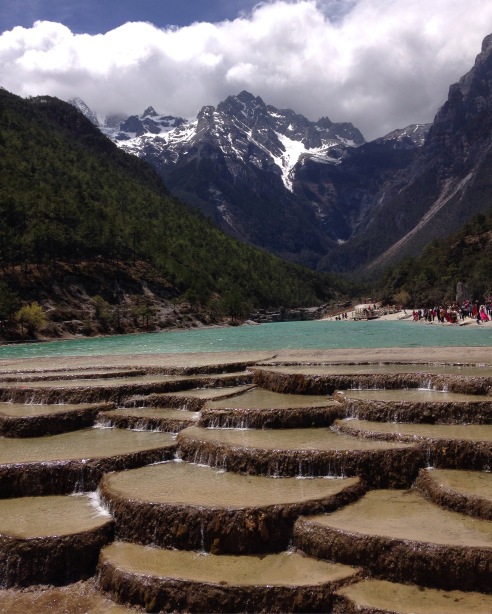 I have come to realise that I have a complete inability to say no to trips. Aside from the obvious places (Beijing and Shanghai) and a few other sites (such as Zhangjiajie and Hangzhou) I am surprisingly ignorant when it comes to places to visit in China. As such, I am really not fussed where I go and find myself wanting to say ‘YES!’ to e very trip being organised (I’ll work out a way to pay for them all later…). My first fairly spontaneous trip took me to Yunnan province. I’d heard the words ‘Lijiang Old Town’ and ‘Tiger Leaping Gorge’ being bandied around when we discussed the trip. I was also vaguely aware, somewhere in the back of my brain, that walking was going to be involved. Little did the now fairly unfit and sciatica-ridden me realise that this path was actually technically part of the Himalayas!
I have come to realise that I have a complete inability to say no to trips. Aside from the obvious places (Beijing and Shanghai) and a few other sites (such as Zhangjiajie and Hangzhou) I am surprisingly ignorant when it comes to places to visit in China. As such, I am really not fussed where I go and find myself wanting to say ‘YES!’ to e very trip being organised (I’ll work out a way to pay for them all later…). My first fairly spontaneous trip took me to Yunnan province. I’d heard the words ‘Lijiang Old Town’ and ‘Tiger Leaping Gorge’ being bandied around when we discussed the trip. I was also vaguely aware, somewhere in the back of my brain, that walking was going to be involved. Little did the now fairly unfit and sciatica-ridden me realise that this path was actually technically part of the Himalayas!
Getting There
Me and a friend from Shandong Caijing Daxue (Shandong Finance and Economcs University) started with a quick dash to the airport bus. In general, most taxi drivers in Jinan are great; the actually use the meter, something I rarely was able to achieve with cabs in Beijing or Shanghai. The one destination that turns these refreshingly nice drivers into the rip-off merchants of Beijing and Shanghai is the airport. As soon as they here the words feijichang (airport), they assume you a tourist that has no concept of where they are in Jinan or how far away the airport is. It’s pretty irritating and on a hot March day (the temperature quickly climbing in China), I couldn’t be bothered with it. The set fee of 20 kuai to ride the airport bus was much more appealing.
This might just be me, but one of the things I enjoy about traveling is exploring new airports. I know they are usually a carbon copy of each other. But having an hour to wander round each one’s oddities is quite fun. Jinan airport goes alongside Kuala Lumpur airport in the list of airports I really dislike (I will explain why I dislike KL in another blog post…it involves molestation on a plane, hunger and card problems). Unbearably hot, barren and hideously expensive, it is not a fun place to spend a lot of time. The cafe staff try to beckon you in, shoving menus at you as soon as you walk past. Not only is the service not appealing, but the staff don’t even flinch when they tell you a coffee is as much as 80 kuai (about £8). That’s expensive by Western prices, let alone Chinese prices where you can feasibly eat three meals for £1.50 a day!
Anyway, after thankfully quite a short wait, we were on our Beijing Capital Airlines flight with a decent on board meal and a hilarious robotised English translation of the safety rules. There’s lots of ways to get to the start of the gorge, some including train/plane combinations. We chose to fly straight to Lijiang and then get a bus to Qiaotou in the morning, organised by our hostel. You can get a bus to half-way along the walk, but I would really recommend starting in Qiaotou as the first part of the walk, although the toughest, had some of the best views. See below, a view right at the start of the walk!

Somewhat oddly, our supposed direct flight stopped for half an hour in a location just outside Lijiang, made us get off and then got back in the air again. After collecting our luggage and a rather bumpy taxi ride during which our ears began to pop from going up hill, we began to see the twinkling lights of Lijiang. We jumped straight into our beds in our hostel, October Inn Guesthouse. I would really recommend this place. We stayed in a 4 bed dorm which was really comfy and clean. It had the added perks of a really friendly owner, the world’s cutest puppy and a fantastic view over Lijiang in the morning.
We started early. Having read things that said there were only buses at about 10am to Qiaotou (where you start the walk to Tiger Leaping Gorge), our hostel owner informed us there was one leaving at about 8am and acquired tickets for us. Unfortunately my phone, where I wrote down all the costs of the trip, has since been stolen so I can’t give specifics on costs, but from memory is wasn’t a lot for the one hour joruney. The bus stopped at the entrance to Tiger Leaping Gorge where a ticket officer came on board to collect our money. For those with a Chinese student card (who are under 24) a ticket is half-price. I believe it was 180 kuai from memory.
The Trek
I’m probably the least fit I have ever been in my life. Back at university (before I hurt my back) I was really active. Even in London I used to get a lot of exercise in as I walked to work and back. Here in Jinan, the only real exertion I get is climbing the 6 flights of stairs to my classroom every morning (a harrowing feat every morning!). Living at SDNU, I am on Jinan’s most central campus and as such rarely need to venture far to meet any of my daily needs. As such, I’m not going to lie, the walk was bloody hard.
Top Tip:
- Map: I think what really would have helped was a decent map. Having been so busy before coming to Yunnan (I’d just got back from Beijing and Lilla had been judging a debating competition all weekend), we were both uncharacteristically disorganised. The map we were given by our hostel, with the added ‘help’ of random markings on the rocks every now and again professing that ‘Tina’s Guesthouse’ or ‘Sean’s Guesthouse’ was in the vague direction we were going, did little to help us judge how far we had come. In fact, the map confused us more than it helped. At one point, we were overjoyed at our progress, congratulating ourselves as we thought we had passed the main uphill stretch. We quickly realised when a donkey began to follow us with its owner offering to carry our stuff that all the main uphill section was still to go, including the infamous 28 turns.
- Sky Ladder: This was scary but a great, quick way of getting out of the gorge. It is a hair raising ladder that takes you back up to the road to Tina’s Guesthoue (where I would recommend leaving your stuff whilst you go down to the gorge). Just don’t think too much about how it’s built and don’t look down!

Food
En-route:
We bought water and snacks before we got on the bus and I would recommend this method of prepping for the walk. The bus stopped en route to Qiaotou to let people buy food and it was already noticeably more expensive than Lijiang. Prices soared on the trek, although hostels had good prices for basics like water (so don’t make the trek unbearable by trying to carry all the water you need).
We went out of peak season so there was a noticeable absence of vendors along the walk (lots of empty shacks that would usually be places where overpriced food/drink was sold), but there were several obvious stops for a warm lunch along the way. Our hostel en-route, Halfway Guesthouse, also had great and reasonably priced meal options.
Food to try in Lijiang:
- Canteen style: There are lots of open canteens in the Old Town. Wander around to find slightly pricey but tasty dishes that include lots of ** style dishes. We got an ‘aubergine boat’ dish with meat in that was delicious and a less successful, rather bland potato pancake.
- Yak’s yoghurt: In Jinan, and China in general really, you rarely come across any dairy products (man I miss cheese!). Yunnan is famous for yak’s milk and makes a variety of sweets and yoghurts out of the stuff. The yoghurt had a very very goaty smell, but as long as you kept the lid on and drank through a straw, it was absolutely delicious and so creamy!
- Yak’s meat: I was kind of expecting to this to be served like a steak, but it is actually dried meat. We didn’t buy any but there is plenty of free samples around Lijiang to try. I was not a massive fan but I’m not a huge meat-eater so I’m not the best judge.
- Tiantian Xian: Located at 47 Wangjiazhuang Xiang, this place was a treasure trove of yummy food! It’s hard to find, my Lonely Planet recommends looking for a sign that says ‘Daily Fresh’ which helped us spot it. Get there before 7pm or the most popular dishes run out. We became obsessed with a potato dish there. It was basically the best mashed potato I’ve ever had: lightly mashed potato with all onions and a bit of spice and all kinds of flavourings. My mouth waters just thinking about it!
- Western Comforts: Lijiang has some welcome Western offerings. N’s Kitchen was the only one really tried (located at 17 Jishan Xiang). We tried to go back on our last day but the specified opening time was a myth so we sadly had to abandon pancakes. But a full English with proper bread, butter and baked beans was heaven! It was actually rather jarring to see a Mc Donald’s and Pizza Hut set against the view of the Jade Dragon Mountain. The ever-present Starbucks was also there, although it had at least made an effort to make it’s building fit into the style of the buildings in the Old Town.
Lijiang Old Town:
The Old Town is a must-see in Lijiang. It is touristy. We went out of tourist season and even then the streets were rammed. The same shops sell the same touristy crap and the same song will haunt you for days as it plays around the streets from shops selling drums. I was also upset to see a McDonalds set against the beautiful backdrop of the mountains. However, elements like the food markets retain a bustling charm. Entry is, from memory (as said my phone with costs on was stolen) about 80kuai for a week’s entry. We didn’t bother paying to enter any of the sites inside the old town. Wandering around was interesting enough, especially around the outskirts where there were less people. It’s quite a maze so take a map or use Baidu Maps on your phone.
Whilst back in Lijiang, we stayed in Mamma Naxi’s Guesthouse. We had an 8 bed dorm but as it was out of season, we had it mostly to ourselves. It was a great place that felt like you were staying in someone’s friendly home rather than a hostel. They also have a wonderful dinner option cooked by Mamma Naxi who will refuse to let you stop eating! Much needed after our long walk.
Jade Dragon Snow Mountain
玉龙雪山 (Yùlóngxuě Shān): I had never heard of this before but luckily Lilla is better at research than me. You can’t miss it when you get to Lijiang, an imposing, beautiful, snow-capped sight. We had seen it from the top of Elephant Hill, ‘hill’ undermining quite how steep this trek is and on one of our days in Lijiang decided to head up it. Unfortunately, the cable car to the top glacier was closed that day due to strong winds so the only way up was a daunting donkey ride. We hadn’t planned to go this far up, it’s a lot more expensive, so we weren’t too upset.

Mama Naxi’s gave us great directions to where to catch the bus to the mountain. Basically, there is a Mao statue to the Western outskirts of Lijiang old town. There a shuttle bus waits until he gets 8 people, or you pay him enough to leave before that. Argue with him over price. Don’t pay more than about 30kuai. He will incessantly stop along the way to try and pick up more people or try and get you to purchase oxygen from the oxygen bars. You don’t need it. Nor do you need the huge coats he will try and get you to rent (take warm clothes if you head right to the top).
If you have a Chinese student card, use it as it makes tickets a lot cheaper. I don’t have exact costs but from memory the whole thing came to around £15. It’s definitely worth it. Tickets range in cost depending on which part you will visit, shuttle buses ferry you to cable car stations to get you to each point. We headed to Spruce Meadow and had some great views of the peak. From there we got the shuttle bus back down to Blue Moon Valley, which was definitely the highlight. The bright blue water has to be seen to be believed and is stunning against the back-drop of the mountain.

Some practical points. We didn’t arrange transfer back to the city, as such we were waiting for a bus to fill up for a long time before we left. We got this taxi from beside Blue Moon Lagoon, it might be easier to go right down to the bottom of the mountain as back at the entrance a bus might fill up quicker. Also, be prepared to be pushed and shoved. As with most Chinese tourism spots, the problem is Chinese tourists. They push and shove and are loud and litter. Try not to let them ruin your experience!
Thing we didn’t do:
- Kunming: From people who we spoke to who have visited here, it’s a fairly uninspiring, standard Chinese city. Our trip was meant to give us a bit of a break from city-life so we didn’t include it on our trip.
- Dali: It was impossible to see everything in our short trip to Yunnan. One of the places I most regret missing out on is Dali. Apparently it is still very traditional.
Verdict:
Even though Lijiang Old Town is very commercial and touristy, it stills retains the illusion that it is traditional and authentic. I think this would be somewhat ruined by hoards of tourists in peak season, even when we went (in low season) tourists were everywhere. However, we managed to find lots of quiet pathways away from the main stretch of town that felt very peaceful. Villages we passed on the walk to Tiger Leaping Gorge were untouched by tourism and were definitely the most ‘Chinese’ places I’ve visited thus far. The trip made me realise that visiting Beijing and Shanghai is not enough to really claim you’ve been to China. They are not ‘real China’, whatever that might be. The walk was tough, made more difficult by the altitude, but I think it’s manageable for most able-bodied people. Just know your own pace and don’t try to keep up with the hard-core trekkers trying to get to the end in one day. In terms of the gorge itself, it’s undeniably an incredible natural feat. But I actually thought some of the sights along the walk itself were better. Being up high affords some fabulous views! As such, I would really recommend starting the walk in Qiaotou rather than being driven to half-way. I think you’d miss out on a lot.

















Leave a comment